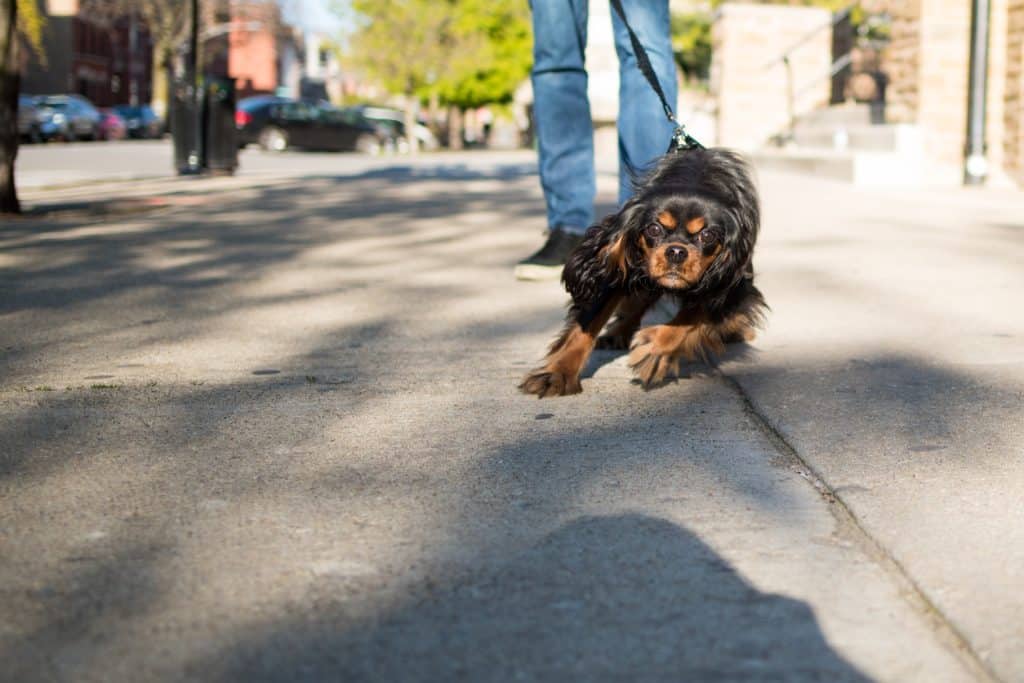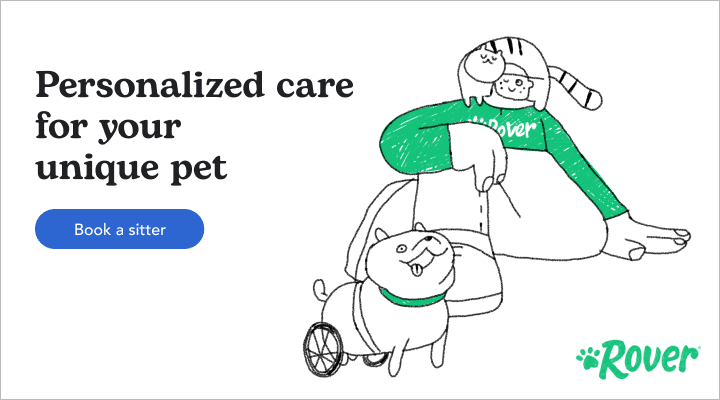You’re strolling along with your four-legged friend, enjoying the sounds of birds and the leaves rustling. Suddenly, your dog tugs hard at the leash, and barks frantically at another pooch on the other side of the street, all serenity is lost. You realize this is a pattern and you may have reactive dog.
Reactivity is over-reactions to triggers that most well-socialized dogs can navigate around. Reactive behaviors can “be a frustrating and stressful experience for both the dog and human(s) involved,” says Boo Blackhurst, CDBC, dog behaviorist and trainer at Animal Behaviour Kent. “[Some] causes of reactive behavior can be influenced by the dog being unwell or in pain.”
Reactivity training — which involves easy actions such as eye contact and rewards — can reduce unwanted behaviors. This can also help you and your dog’s bond, leading to more trust and communication. Let’s look at what’s going on and how to help.
Signs of Reactivity in Dogs
Note that reactivity doesn’t only occur when a dog is on-leash: it can crop up in your home or backyard. Numerous signs indicate reactivity, and they aren’t always loud or overt. “There are several stress signals involved, too,” says Blackhurst.
“Reactive behaviors in dogs can be indicated by several signs, including vocalizations, movements, and body language,” Blackhurst continues. Some of the main ones include:
- Hypervigilance (e.g., excessive scanning around them, fast head turns)
- Piloerection (the hairs on their back standing up)
- Slowing down and stillness, tension in the body
- Wide-eyed stare with dilated pupils
- Ears bent forward or back
- Cowering, hiding, trying to escape
- Lifting a paw
- Sniffing the ground out of context
- Lip curling or showing teeth
- Tail movements (e.g., down or in-between legs can indicate significant fear)
- Vocalizations, such as high-pitched barking or growling
- Lunging (commonly observed when the dog is on a lead or restricted in some way)
Blackhurst notes that vocalizations and tail movements can vary between breeds and should be read “in context with other signals.”
What Causes Reactivity?
Reactivity is psychological and physiological. Emotions such as fear and excitement occur on a psychological level, while, physiologically, the heart rate goes up and the body is flooded with the stress hormone cortisol.
Various stimuli can trigger reactivity, such as seeing other dogs, strangers, or children. But this reaction doesn’t occur for no reason — one or more causes can underpin it.
Trauma
Your dog may have previously faced a one-off or series of traumatic events during which their body language and vocalizations were not recognized. Now, they’re reactive because “they have had to resort to extreme behaviors as the early “asking politely” signs were ignored,” says Jo Sellers, accredited dog trainer and founder of Pippin Pets Dog Training.
You might expect rescue dogs to be more reactive. But this isn’t necessarily the case, says Sellers. Other non-environmental factors, such as genetics and hormones, can play a role.
That said, remember that rescue dogs are more likely to have faced trauma of some kind. For example, “living in kennels can be very stressful for dogs, especially those that have only known homes beforehand,” Sellers notes. “Noises, smells, and unfamiliarity can exacerbate anxiety that was not triggered before but inherent in the dog.”
Incomplete or insufficient socialization
Socialization is critical in your dog’s early years, and experiences during this time “can inform your dog on what is safe and unsafe,” explains Sellers. “It’s important to allow your dog to investigate and experience lots of new places, sights, sounds, and smells, as this helps build their confidence and resilience.” Without these experiences, your dog is more likely to become fearful and anxious in “normal” situations.
Meanwhile, being on the receiving end of an “over-boisterous dog or dog play can cause your dog to be fearful of similar dogs,” she continues. “Therefore, they may react by barking to keep the other dog away.”

Image credit: Page Light Studios | iStock
Genetics
Anxiety inducing hormones can be passed genetically from mom dogs and their pups, Sellers reveals. However, anxious genes can also result from bad breeding, “where the look of the dog is chosen over any temperament, health, or behavioral traits,” she adds.
All dog breeds can display reactivity. “However, research suggests some breeds may have a longer ‘sensitive’ period during the critical puppy developmental stage, which could contribute to a higher chance of reactive behaviors,” reveals Blackhurst.
In one small study, for example, Cavalier King Charles Spaniels showed “later onset fear-related avoidance” than German Shepherds or Yorkshire Terriers. That said, “we should understand that not all dogs of these breeds will necessarily exhibit reactive behavior,” Blackhurst added.
Handling
This entails how you hold, touch, and interact with your pooch and how other dogs engage with your canine. For instance, “heavy handling, intimidation, fearful methods, and aversive equipment” can cause your dog to associate pain with certain stimuli or situations. Sellers says this can result in “reactive associations with that trigger.”
What To Do While Meeting Other Dogs & Owners On A Walk
Although you might be aware that your dog is reactive, other owners (and their canines) won’t know this is the case. Communicate that your pup — and you — need space to help prevent a situation from escalating.
“Ask the approaching person to put their dog on a lead,” Sellers says. “Sadly, not all owners carry a lead, so I would strongly ask them to give a bit of space. I try to be forceful with my words without being rude or upset, and insist they come and get their dog if their dog is not responding to them.”
It can be tricky to know what to say in such situations, so Sellers suggests phrases such as:
- “‘We are in training, so need some space”
- “They’re not feeling so sociable today”
- “They’re feeling a bit grumpy today”
- “Please keep your dog away from us”
- “My dog is contagious with mange/kennel cough/insert medical condition..!”
Dressing your dog in yellow ‘warning’ apparel, such as a jacket, bandana, or leash sleeve, can also indicate to other owners that your dog is reactive.
If the other owner and their dog continue approaching, “try and create some space away from them and move, as standing still often gets the dog more wound up,” Sellers suggests. “Redirect your dog’s attention and move away. Once the other dog has passed, drop some treats for them to forage, as sniffing reduces their heart rate and can calm them down.”
Consider other people’s dogs, too
For owners whose dog isn’t reactive, it’s important to consider other canines’ needs. “All dogs have a personal space boundary, and this is really important to respect,” says Sellers. “Your dog may be ‘friendly’, but this does not mean the other dog is willing to have strangers (human or dog) close up to them.”
Taking other dogs’ behavior into account can also aid in keeping yours safe. “If there is a dog on a lead approaching, get your dog close and put their lead on,” Sellers says. She adds that teaching your four-legged pal early on that not all dogs are OK to approach is also vital.
Calming Your Dog During Reactive Moments
Deescalating reactivity as quickly as possible benefits you, your canine, and those around you. According to James Hare, a qualified dog trainer and founder of Newquay Puppy and Dog Training, numerous steps can aid in achieving this.
Redirect your dog
So how do you calm a reactive dog? “The best option is to redirect your dog away, give them space, and help them relax,” he says. Your canine likely has a favorite treat that you can use to gently guide them towards a trigger-free area. Don’t forget to give plenty of rewarding words and strokes once they’ve calmed down!

Image credit: DjelicS | istock
No punishments
Don’t punish or hold your pup to stop their reaction, Hare notes. “Never restrict or forcibly hold [them], unless in an absolute emergency. What happens at the human end of the lead has a massive effect on the dog’s end of the lead.”
Restricting your dog, such as by making the lead tighter, will likely increase their feelings of fear or worry and exacerbate their reactions. Furthermore, adds Blackhurst, “repeatedly punishing dogs for displaying reactive behaviors may bypass the precursor signals and cause a dog to exhibit more extreme behaviors without warning.”
Stay calm
Another important factor? “Staying calm ourselves is a big piece of the puzzle,” says Hare. Dogs can sense worry, so your stress may further provoke theirs.
Can You Train Reactivity Long-Term?
In a word, yes. But understand you can’t “cure” reactivity, as it’s not a condition — rather a set of behaviors stemming from psychological hurdles. Several steps can aid in reducing reactivity and calming your dog in stressful situations.
Know what motivates your dog
Understanding what your dog positively reacts to, especially in stressful situations, is important. Do they respond best to soothing strokes, their favorite treat, or their go-to toy?Reinforce and reward eye contact.
Reinforce and reward eye contact
Want to build trust with your canine? “Eye contact is one of the top behaviors I teach, as it forms such a huge part of ongoing training,” Hare says. When your dog looks at you, hold their gaze and reward their behavior.

Image credit: Edwin Tan I iStock
Turn and walk away from triggers
Easier said than done, this might take a little bit of trial, error, and extra training sessions to find a method that works for you and your dog. Hare recommends teaching a hand touch signal or a “let’s go” verbal cue. “We never want to yank a dog on a lead, especially if it is wearing a collar,” he states.
Avoid stressors and find more isolated routes
If you know that other dogs trigger reactivity in your pooch, avoid situations where there will be lots of canines — such as a dog park. Do your best to avoid others and give your dog space where possible.
Some dog trainers even suggest not walking your dog at all until you have built a stronger bond with them. If this is you, there are plenty of indoor activities to meet your dog’s physical and mental needs.
Try counter-conditioning
This involves turning a “bad” trigger into a “good” one by rewarding your pup with a treat whenever they come across it. “Through conditioning behaviors, dogs learn via positive reinforcement,” Hare notes.
So how long does it take to train reactivity and reduce behaviors? “This is the million-dollar question!” says Hare. Essentially, there’s no set amount of time: the process varies between dogs as numerous factors are at play. For instance, “The more practice, counter-conditioning, and reinforcement of [positive] behaviors take place, then results may come quicker,” Hare explains.
If training alone doesn’t have much impact, speak to your vet — as pain can also trigger reactive-like actions. “It might be your dog needs a little extra help, such as Galen Myotherapy, hydrotherapy, or even medication,” says Hare. “We always want to do what we can to work with dogs on reinforcement before we look at any medication. But, sometimes, it is essential for their benefit.”

Vincent Scherer | iStock
Comparing Reactivity to Excitement Or Aggression
There’s a difference between a reactive dog and an aggressive or excited dog. While all three can involve similar behaviors, varying factors separate them — such as the context of a situation or the dog’s previous experiences. Often, feelings of fear or anxiety fuel reactivity. Determining whether your dog is reactive, aggressive, or excited is important, reveals Blackhurst, as doing so can aid in “treating” the issue.
While some reactions can appear similar, “reactivity differs from aggression and excitement in a few ways,” says Blackhurst.
“Reactivity is generally perceived as an overreaction to a situation, which doesn’t necessarily indicate aggression,” she states. On the other hand, aggression is a measure designed to put distance between the dog and the trigger or harm them.
Happy or excited behavior vs. reactivity
So what’s the difference between an excited dog and a happy dog? When excited, a dog may start wagging its tail or sticking its tongue out. But these can quickly evolve into more extreme reactive behaviors, “often due to an added frustration element,” Blackhurst explains.
For instance, you might be driving with your canine when they spot a dog walking outside. A reactive behavior, says Blackhurst, would see your dog “begin to vocalize and lunge at the windows.”
It’s also important to remember that, in a reactive situation, an excited-looking dog doesn’t necessarily mean a happy dog. In fact, Blackhurst notes, this is likely a sign that your pup is feeling uncomfortable.
Are all reactive dogs aggressive?
Just because your four-legged friend is reactive doesn’t mean they’re aggressive. “Some reactive behaviors may appear aggressive to an observer, [but] we should understand the reasons for the behavior before making assumptions,” asserts Blackhurst. “It can depend on the individual, their learning history, genetics, and the context in which reactivity is displayed.”
The occasional reactive outburst is likely not a cause for too much concern. However, the issue becomes problematic when your dog frequently becomes anxious, aggressive, or overexcited in certain environments or when faced with particular stimuli. At this time, you should visit a qualified dog behaviorist or trainer to see what’s going on.


